|
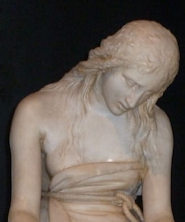 Dwight
Peck's personal website Dwight
Peck's personal website
Collectibles, Odds and Ends
Photos of various things we thought were pretty funny at the time
You may not find this terribly rewarding unless you're included here, so this is a good time for casual and random browsers to turn back before they get too caught up in the sweep and majesty of the proceedings and can't let go.
Mary Magdalene
Mary Magdalene, Mary of Magdala, was mentioned several times in the canonical New Testament gospels as one of the female followers of Jesus, perhaps the most important of them and apparently a financial supporter as well. She was associated with his ministry, present at his crucifixion, and in some accounts a witness to his resurrection. In the post-canonical gospels, especially those of a Gnostic bent, she was portrayed as a special confidant of Jesus, the chief recipient of his message and envied by the male apostles for her privileged relationship with the master.
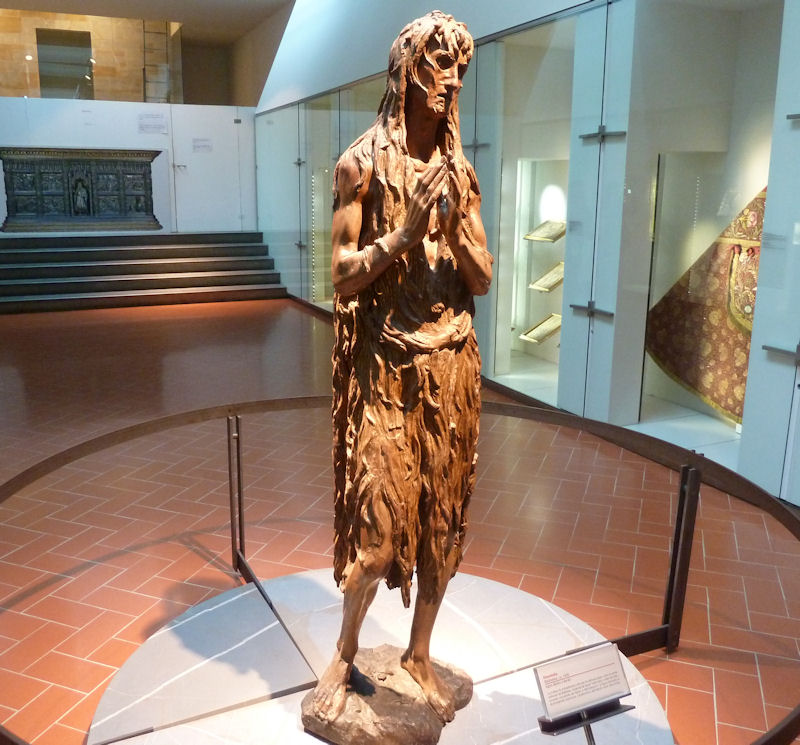
This is undoubtedly the most harrowing of all Magdalenes, Donatello's aged and emaciated Penitent Magdalene, a sculpture in wood, ca. 1455, in the Museo dell'Opera del Duomo in Florence. [viewed in 2011]
Over time, this Mary (from whom ‘seven demons’ were cast out) was sometimes conflated with a few of the other women mentioned in the gospels, particularly Mary of Bethany and the ‘sinful woman’ who anointed Jesus’ feet with oil (in Luke), and possibly with the ‘woman taken in adultery’ as well (‘Go and sin no more’, in John) [and later, perhaps with St Mary of Egypt, a 4th-5th century reformed prostitute and hermit near the River Jordan, patron saint of penitents, popular from the 7th century].
These confusions were set in stone in a homily by Pope Gregory I the Great at the end of the 6th century, and thereafter there were several strains of Mary’s iconography through the Middle Ages, Mary one of the chief mourners at the crucifixion, Mary the penitent prostitute [as Donatello's, above], and (by the 13th century) Mary who spread the Christian message in southern France, having arrived there with Lazarus in a rudderless boat, and lived out her life as an ascetic hermit in Provence (Jacobus de Voragine's Golden Legend).
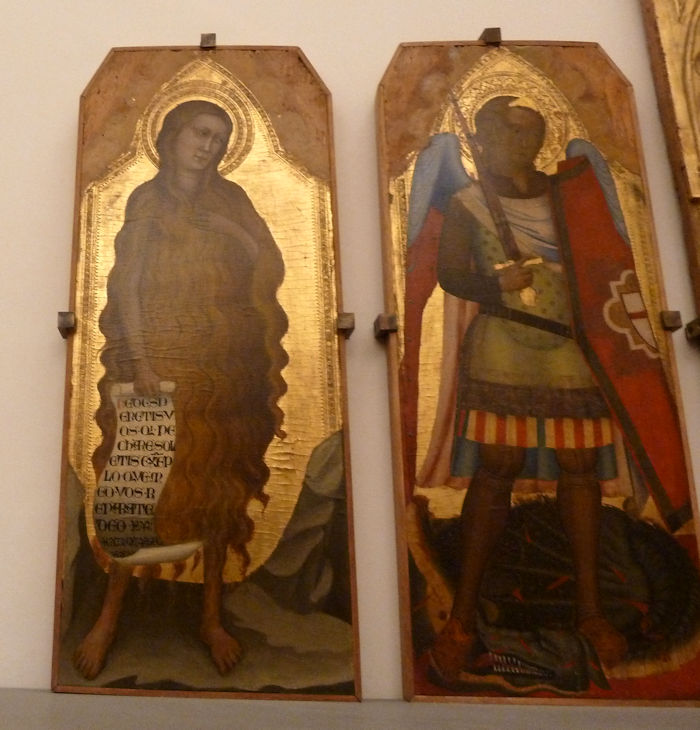
The ''Repentant Magdalene and eight stories of her life', tempera on wood, by the so-called Maestro della Maddalena, ca. 1285, in the Galleria dell'Accademia in Florence. Long hair was iconographically associated with prostitutes, and conveniently covered up the territory that, a few centuries later, would likely be more artfully exposed. [The guy on the right is St George, with dragon.]
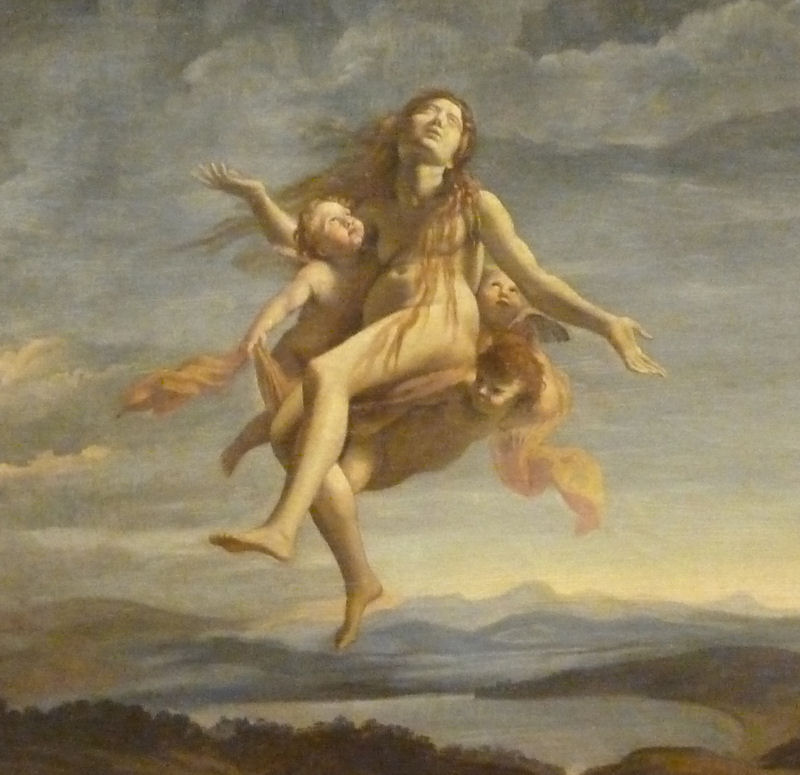
Same long hair, more artfully exposed territory. [What really happened to Mary Magdalene? -- the naked kids got her. ]
This is the top half of the 'Assunzione della Maddalena' (ca. 1605), by Giovanni Lanfranco, Museo di Capodimonte in Naples.
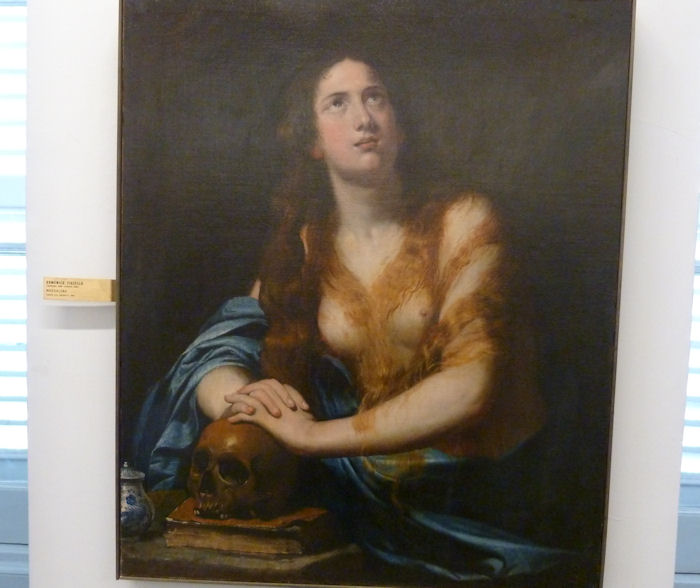
The portrayal of Mary back and forth, from devoted follower to vile hooker to misguided young lady to penitent sinner to Christ's only real friend, followed historical cycles. This entry by Domenico Fiasella is pious enough and it's got the skull and the book, the long hair and the goods out. It's in the Palazzo Bianco in Genoa. [The evolution of the Magdalene's story can be followed in Bart Ehrman's fascinating Peter, Paul, & Mary Magdalene: the followers of Jesus in history and legend (Oxford UP, 2006)].

Canova's brilliant 'La Maddalena penitente', 1794-96 . . .
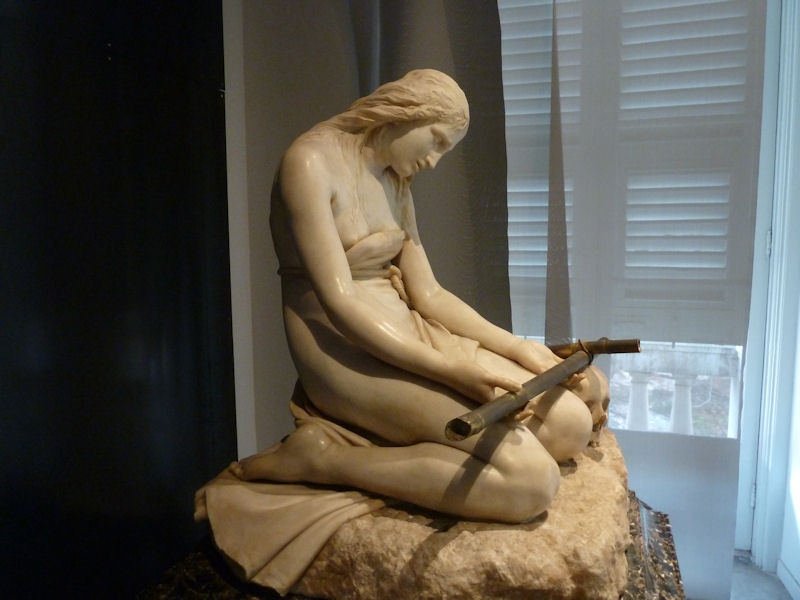
. . . in the Palazzo Bianco in Genoa (and another version in the Hermitage in St Petersburg).
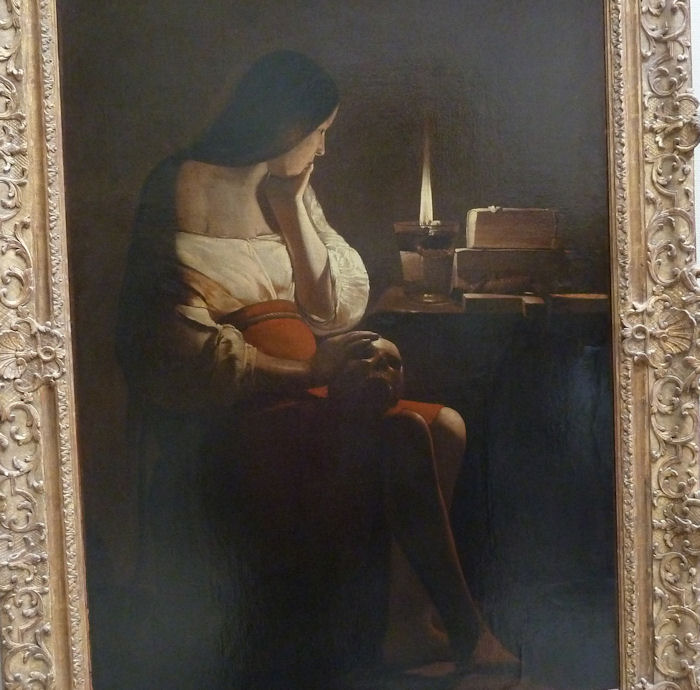
A pensive Magdalene, with a night light, staring into space or the past, by Georges de la Tour, ca. 1645, in the Louvre

Oh, don't remind us! Donatello's Magdalene featured in a coffee-table book seen in Ravenna, 2013

|

|
More entries for our "Mary Magdalene (saint or sinner?)" collection -- these are by Giuseppi Crespi and Giangioseffo Dal Sole, in the Pinacoteca Nazionale in Bologna [2014]

-- Now that is a very impressive skull! I think I'm in love. By Ubaldo Gandolfi (1728–1781), in the City Art Collections (Collezioni Comunali d'Arte), also in Bologna

An affectless Mary Magdalene (showing only Mary Magdalene's half of the picture), by Benozzo Gozzoli (1466), who lived in San Gimignano for four years; in the City Museum in San Gimignano. She seems to be carrying a rocket propelled grenade, but it's probably the traditional alabaster jar in which she held the oil for anointing Jesus' feet. November 2014

Christ dressed as Russell Brand, with Mary Magdalene in the 'Noli me tangere' scenario, by the Caravaggesque Neapolitan Battistello Caracciolo, ca. 1618. In the municipal museum in the Palazzo Pretorio in Prato, Tuscany. [In the Gospel of John, the resurrected Jesus came to Mary in the garden near the tomb, and she tried to touch him, but he said 'Noli me tangere -- Don't touch me, for I have not yet ascended to my father'.] November 2014.
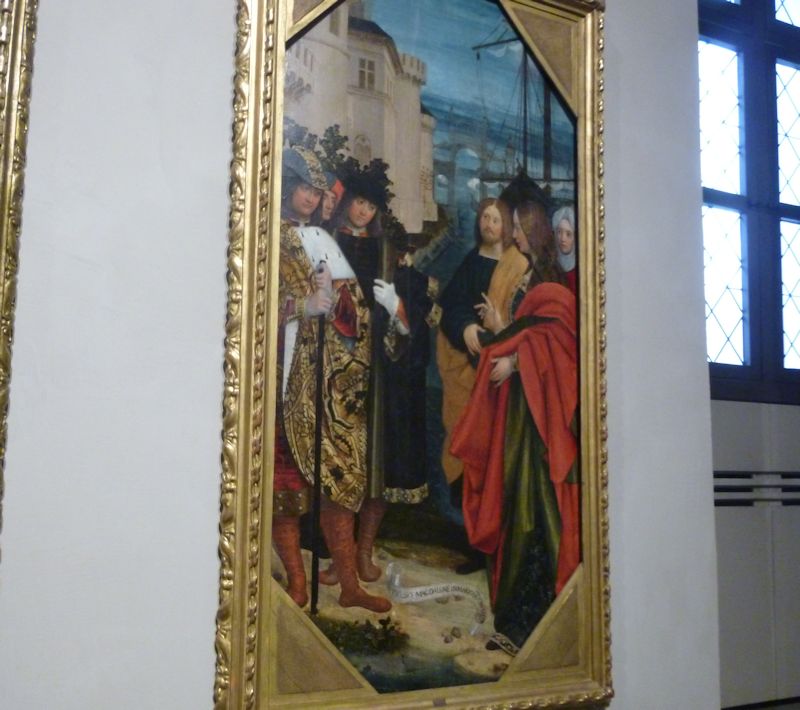
This one illustrates the later medieval legend of Mary -- Defendente Ferrari in about 1505 shows the Magdalene disembarking in Marseilles, after which she converted the Provence region to Christianity and went off to live as a hermit in a cave nearby. When she died thirty years later, the angels came and fetched her, but Benedictine and Dominican monks battled one another for years over her remains. This is in Palazzo Madama in Torino (November 2014).

This is Mary Magdalene's whole life story in pine wood episodes (but missing the arrival in Marseilles), from about 1300. Also in the Palazzo Madama. November 2014

A rather tentative penitent, with somebody's skull, by the early 17th century Jacques Blanchard, in the the Musée Fabre in Montpellier, France (December 2014)

A Mary Magdalene half-heartedly in the "Penitent Magdalene" tradition (Workshop of Giampietrino, early 16th century) in the Pinacoteca Malaspina in Pavia [February 2015]

Another Penitent Magdalene. -- Get over it! (by Francesco Cairo of Milan, who specialized in ecstatic females, frequently with turbans on), also in the Pinacoteca Malaspina in Pavia

A less ecstatic, less penitent, but far less interesting Mary Magdalene (anointments jar, but no skull!) by Carlo Cornara, also from Milan, also in the Pinacoteca Malaspina, viewed in 2015

And now back to the ecstatic and very penitent Magdalene tradition, somewhat overwrought, with skull and crucifix (by Domenico Piola of Genoa, 17th century), also in the Pinacoteca Malaspina
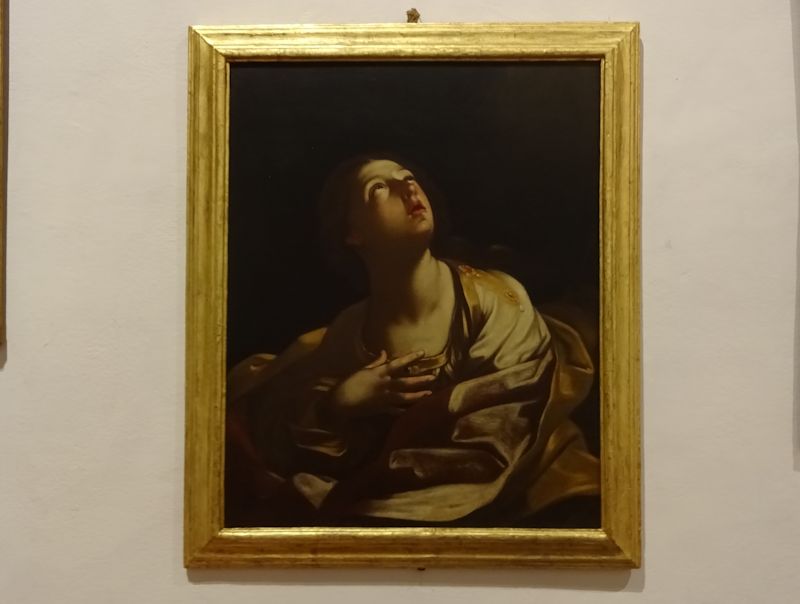
An indifferent Mary Magdalene 'in ecstasy', Scuola Romana, 17th century, in the Montefeltro Ducal Palace in Gubbio (November 2015)
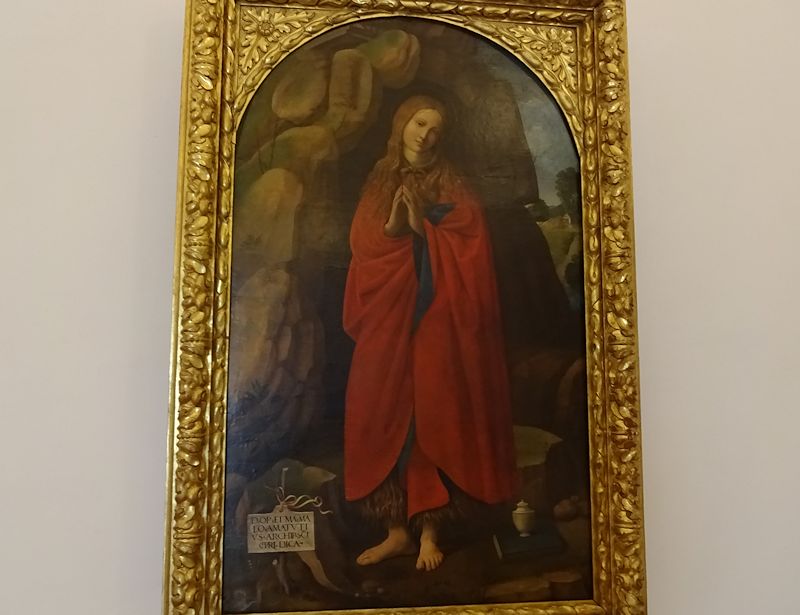
A much more interesting Magdalene, looking more pious than prostitutish, evidently at peace in her hermit's cave in the Provence in France, by Timoteo Viti, early 16th century, in the Ducal Palace in Urbino [viewed in 2015]

This, in the Kunstmuseum in Basel, Switzerland, is labeled as a Mary Magdalene by Cranach the Elder, but unlike any other Mary Magdalene we've seen anywhere and not too much like Cranach's well-known 'Saxon lady as Mary Magdalene'. She is, however, holding a jar of anointment oil. (June 2016)
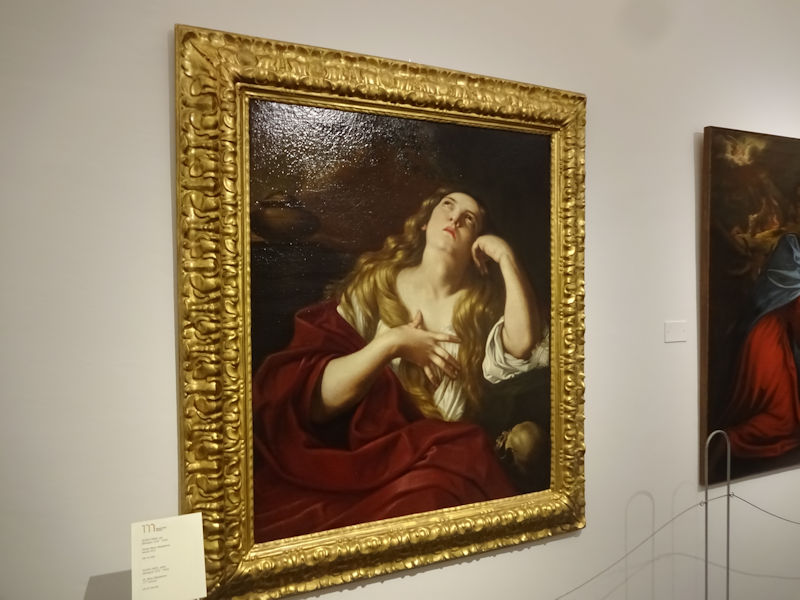
A doubtfully penitentish Mary Magdalene (attributed to Guido Reni), in the pinacoteca in the Chiesa di Santa Caterina, Treviso [ March 2017]

A perhaps pre-penitential Magdalene by the sculptor Giovanni Bonazza of Padua, active in the late 17th and early 18th centuries, in the fine Museo Civico in the Church of the Eremitani, Padua [March 2017]

A striking Mary Magdalene in extremis (with friends) by the fascinating sculptor in terra cotta Guido Mazzoni originally from Modena, late 15th century; also in the Church of the Eremitani, Padua

Another in the "Noli me tangere" tradition, this by Giotto, amongst his frescoes completed in about 1306 in the fabulous Cappella degli Scrovegni, or Scrovegni Chapel, in Padua (March 2017).

Two versions of Mary Magdalene, not much alike except that in both she's got some clothes on, by a 'Pittore emiliano, XVII secolo' and a 'Pittore marchigiano, XVIII secolo', both formerly in the monastery of Santa Chiara (the Poor Clares) in San Marino, which closed in 1971. Now in the Museo di Stato there. December 2017.

A carved-wood Mary Magdalene by Giovanni Angelo del Maino, ca. 1525, in the Castello Sforzesco in Milan (February 2018)

St John, Mary, and Magdalene from a carved wooden tableau attributed to the Maestro del Compianti, Master of the Mourned, ca. 1515. The pose of Mary Magdalene, for a standard Crucifixion scene, is priceless. Also in the Castello Sforzesco in Milan [viewed in February 2018]
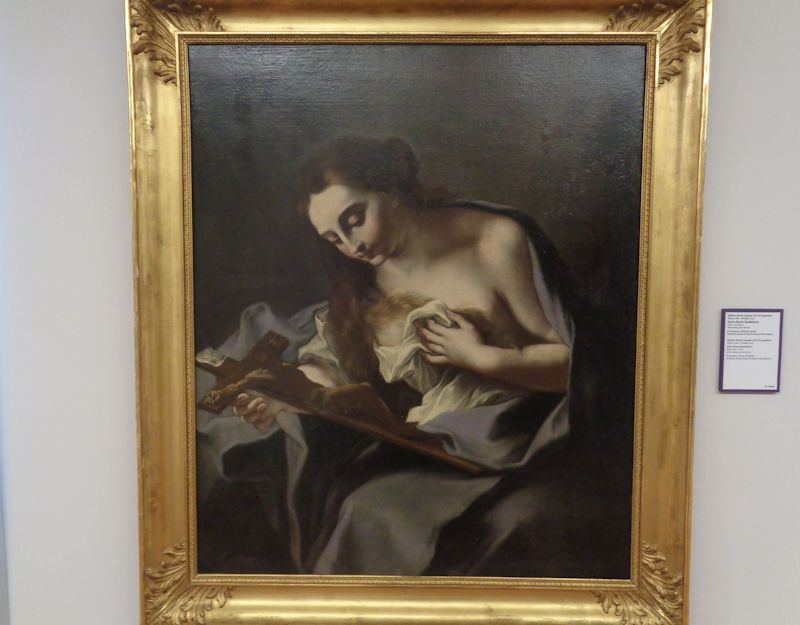
And on a less colorful note: Mary Magdalene, more contemplative and less penitential than often seen, by Stefano Maria Legnani (Il Legnanino ), ca. 1705, in the Museo Civico di Crema e del Cremasco, in downtown Crema. (February 2018)

Another "Noli me tangere" and another Jesus in a nice hat, in the Museo Civico Cremasco in Crema, by Il Conciabracci (Tommaso Pombioli) of Crema, ca. 1636 (February 2018)

In the baroque Church of Santa Maria Maddalena in Alba, the picture of Mary Magdalene over the main altar, between twisted porphyry columns, is by a fellow called Biscarra in 1825. [May 2018]
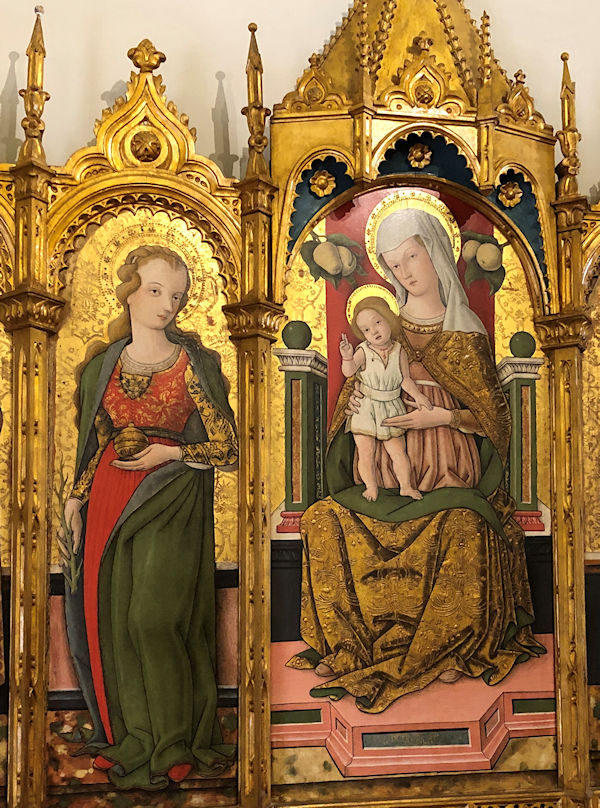
An extract from the 'Madonna Enthroned with Bambino', by Pietro Alemanno -- Baby Jesus with a precocious but listless blessing alongside the ugliest Mary Magdalene we've ever seen (the ointment jar is the Magdalene's tell). In the Pinacoteca di Ascoli Piceno [viewed in 2022]

Another special favorite: the Repentant Magdalene (ca.1635-40) by Georges de la Tour, the master of candlelit chiaroscuro scenes. In the National Gallery of Art, Washington, DC (viewed in 2023)

Here is a revision of Titian's 1531 'Penitent Magdalene', based on his 1565 version (now in the Hermitage in St Petersburg) and dated to 1567. He made several versions of this work to please insistent patrons, but it has been argued that this particular one was actually executed in 1547 for the Cardinal Alessandro Farnese. In the Museo di Capodimonte in Naples, viewed in October 2023 (and October 2024)

Mary Magdalene, so often portrayed in art as a distraught penitent sinner, is here shown as a sophisticated and elegant worshipper, with the little jar of ointment that was one of her traditional accompaniments. This fine piece is by Piero di Cosimo of Florence, made in about 1495-1500. In the Palazzo Barberini, Rome, October 2024.
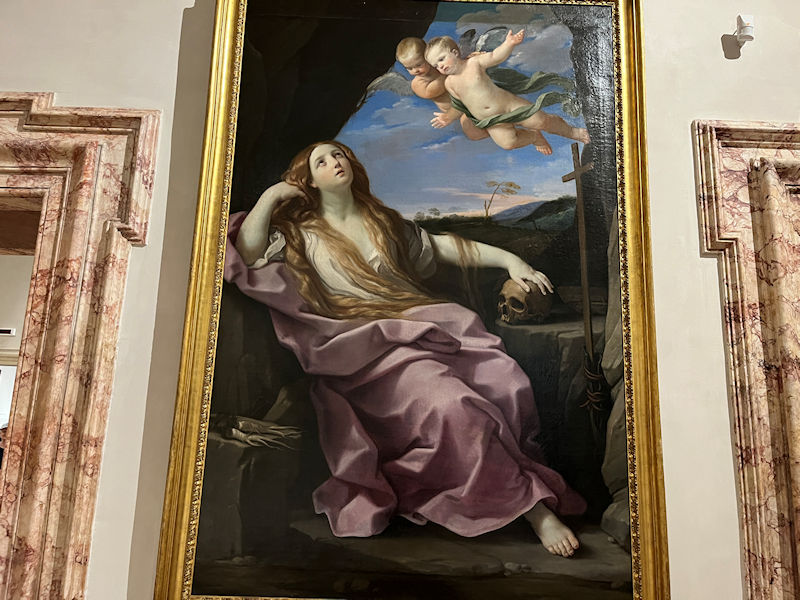
The 'Penitent Magdalene' is a famous work by Guido Reni, done in 1631-1632, and given to Antonio Barberini in 1641. It's said to be a outstanding example of 'sacred beauty' ('divinely inspired, elegantly pathetic, sensual yet restrained', with 'scattered signs of penitence throughout the austere cave').In the Palazzo Barberini, Rome, October 2024.
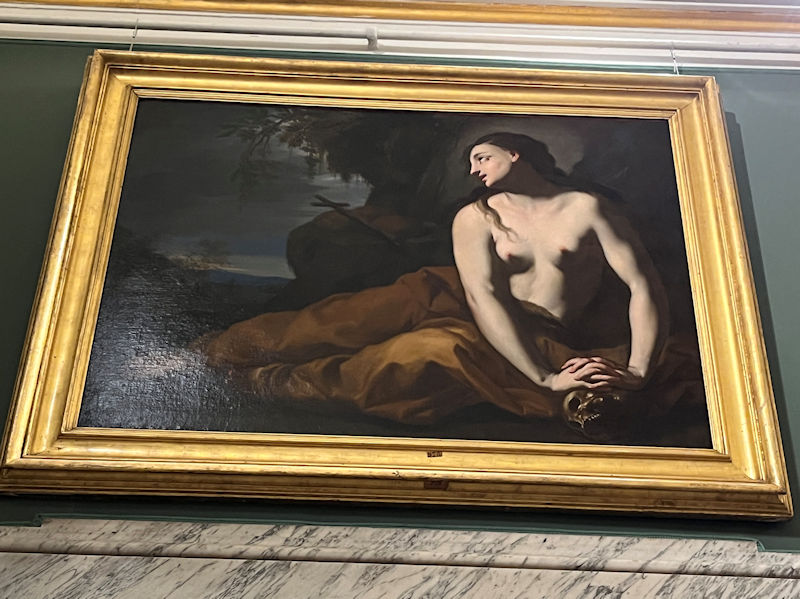
'Mary Magdalene' by Francesco Trevisani (1656-1746). In series 5 (2021) of Bendor Grosvenor's BBC show Britain's Lost Masterpieces, one episode is focused on a Mary Magdalene in the Brighton Museum, which Bendor's restorers were able to show was made by Trevisani, not this version, of course. In the Galleria Corsini, Rome, October 2024
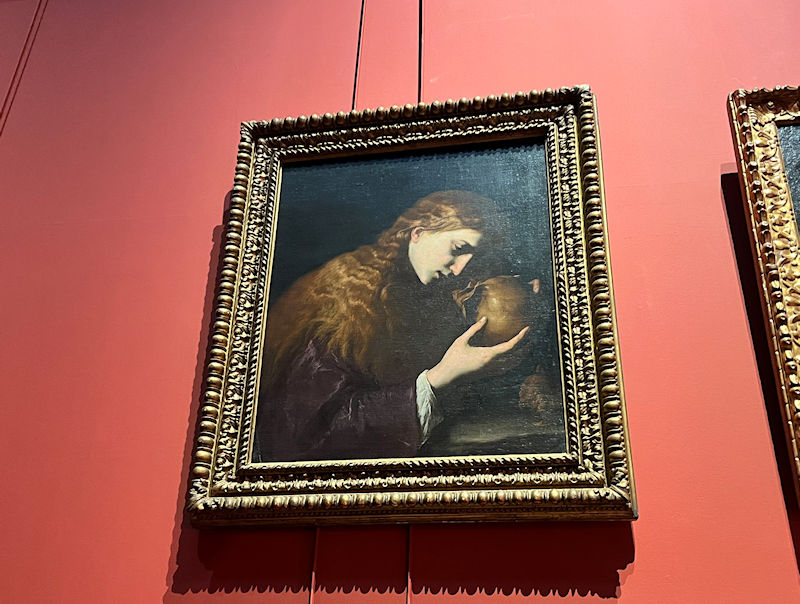
'Maddalena in meditazione', c.1620, by Jusepe de Ribera (1591-1652), born in Spain but working in Rome ca. 1613-1616 and then in Naples (then under Spanish rule) for the rest of his life.

Artemisia's Magdalene returns to Naples. Not the most stirring of Artemisia's many works, but very interesting nonetheless -- in so many ways, it runs across the usual symbolisms associated with the Magdalene's pictures. The urn of precious oil is there (there was a mistaken assumption that she was the lady who anointed Jesus's feet with precious oil), and she's broken off her necklace, suggesting a confident change from her former life perhaps. In the Monastery of Santa Clara, Naples, October 2024

A disappointing view of 'La Maddalena' by Andrea Vaccaro (Naples, 1604-1670). In St Martin's Monastery, Naples, October 2024

'Mary Magdalene Renouncing the Worldly Life' (early 1650s), by Bartolomé Esteban Murillo of Seville, with strong influences of Caravaggio and Zurbaran, thematically fully in line with the Counter Reformation doctrine of the Magdalene's remorseful conversion.
And for comparison, this is the reformed prostitute and dedicated ascetic St Mary of Egypt

Sometimes confused with Mary Magdalene, St Mary of Egypt (Santa Maria Egiziaca), patron saint of penitents, strugglers for chastity, demons, and skin diseases, was a 4th or 5th century insatiable nymphomaniac who traveled from Alexandria to Jerusalem to find even more sexual partners, where luckily she glimpsed a relic of the True Cross and went off happily to the desert to live as a penitent hermit (by a 'Painter from Ferrara', 15th century). In the Museo Civico di Castelvecchio in Verona. May 2016 |
 Feedback
and suggestions are welcome if positive, resented if negative, Feedback
and suggestions are welcome if positive, resented if negative,  .
All rights reserved, all wrongs avenged. Posted 14 August 2019, updated 17 May 2025. .
All rights reserved, all wrongs avenged. Posted 14 August 2019, updated 17 May 2025.
|
 Dwight
Peck's personal website
Dwight
Peck's personal website










































